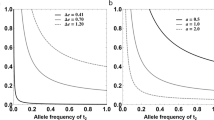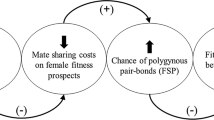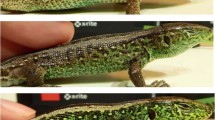Abstract
Recent theory on sexual selection1–4 suggests that females in species without paternal care choose mates by their secondary sexual characters because these indicate genotypic quality which will be transmitted to the offspring. These ideas are not yet empiri-cally supported as data quantifying the relationship between female mate choice and female reproductive success are lacking. Only in one case, in Colias butterflies, has it been demonstrated unequivo-cally that females choose 'good genotypes' as mates5 and there is only one study, on Drosophila, demonstrating that mate choice increases one component of offspring fitness6. Spur length of male pheasants (Phasianus colchicus) correlates with various fitness-related properties7. We here present the first experimental field data showing that female pheasants select mates on the basis of male spur length and that female mate choice correlates with female reproductive success.
This is a preview of subscription content, access via your institution
Access options
Subscribe to this journal
Receive 51 print issues and online access
$199.00 per year
only $3.90 per issue
Buy this article
- Purchase on Springer Link
- Instant access to full article PDF
Prices may be subject to local taxes which are calculated during checkout
Similar content being viewed by others
References
Andersson, M. Biol. J. Linn. Soc. 17, 375–393 (1982).
Hamilton, W. D. & Zuk, M. Science 218, 384–387 (1982).
Kodric-Brown, A. & Brown, J. H. Am. Nat. 124, 309–323 (1984).
Andersson, M. Evolution 40, 804–816 (1986).
Walt, W. B., Carter, P. A. & Donohue, K. Science 233, 1187–1190 (1986).
Partridge, L. Nature 283, 290–291 (1980).
Göransson G., von Schantz, T., Fröberg, I., Helgée, A. & Wittzell, H. Evolution, submitted.
Koubek, P. & Hrabe, V. Folia Zool. 33, 303–313 (1984).
Jennrich, R. I. & Turner, F. B. J. theor. Biol. 22, 227–237 (1969).
Alatalo, R. V., Lundberg, A. & Glynn, C. Nature 323, 152–153 (1986).
Altmann, S. A., Wagner, S. S. & Lenington, S. Behav. Ecol. Sociobiol. 2, 397–410 (1977).
Davison, G. W. H. J. Zool. 206, 353–366 (1985).
Jeffreys, A. J., Wilson, V. & Thein, S. L. Nature 314, 67–73 (1985).
Maynard Smith, J. J. theor. Biol. 115, 1–8 (1985).
Jones, J. S. Trends Ecol. Evol. 2, 35–38 (1987).
Lilliefors, H. W. J. Am. Statist. Assoc. 64, 399–402 (1967).
Göransson, G. thesis, Univ. of Lund, 1980.
Dixon, K. R. & Chapman, J. A. Ecology 61, 1040–1044 (1980).
Crook, J. H. & Butterfield, P. A. in Social Behaviour in Birds and Mammals (ed. Crook, J. H.) 211–248 (Academic, London, 1970).
Kalinoski, R. Condor 77, 375–384 (1975).
Baker, M. C. & Fox, S. F. Evolution 32, 697–711 (1978).
Author information
Authors and Affiliations
Rights and permissions
About this article
Cite this article
von Schantz, T., Göransson, G., Andersson, G. et al. Female choice selects for a viability-based male trait in pheasants. Nature 337, 166–169 (1989). https://doi.org/10.1038/337166a0
Received:
Accepted:
Issue Date:
DOI: https://doi.org/10.1038/337166a0
This article is cited by
-
Mating behaviour of the large-head resin bee Heriades truncorum (Megachilidae: Osminii) suggests female plastic strategy in selection of a mating partner and male quality assessment
Apidologie (2022)
-
Male genital lobe morphology affects the chance to copulate in Drosophila pachea
BMC Ecology and Evolution (2021)
-
Analysis of the source of aggressiveness in gamecocks
Scientific Reports (2020)
-
Free mate choice enhances conservation breeding in the endangered giant panda
Nature Communications (2015)
-
Is female preference for large sexual ornaments due to a bias to escape predation risk?
BMC Evolutionary Biology (2012)
Comments
By submitting a comment you agree to abide by our Terms and Community Guidelines. If you find something abusive or that does not comply with our terms or guidelines please flag it as inappropriate.



